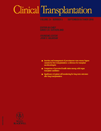Insertion and management of percutaneous veno-venous bypass cannula for liver transplantation: a reference for transplant anesthesiologists
Abstract
Sakai T, Gligor S, Diulus J, McAffee R, Marsh JW, Planinsic RM. Insertion and management of percutaneous veno-venous bypass cannula for liver transplantation: a reference for transplant anesthesiologists.Clin Transplant 2009 DOI: 10.1111/j.1399-0012.2009.01145.x © 2009 John Wiley & Sons A/S.
Abstract: Surgical advances using the retrohepatic caval preservation technique in liver transplantation (LT) has significantly decreased the need for veno-venous bypass (VVB). However, VVB still remains a viable adjunct of LT. The venous return cannula has traditionally been inserted using a cut-down technique via the axillary vein, but this technique carries significant risks for lymphorrhea, infection, or nerve damage. Since 2001, our institution has routinely used VVB in adult LT surgery. Percutaneous insertion of an internal jugular venous return cannula is performed by the attending anesthesiologist. The aim of this report is to describe the method of insertion and management of a percutaneous veno-venous return cannula in the internal jugular vein during LT. In-depth detail as well as video clips will provide a reference for LT centers wishing to apply this method in their practice.




